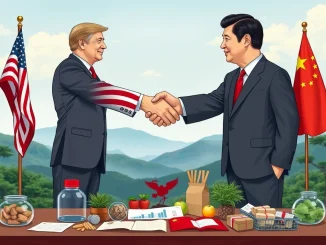
Hold onto your hats, tech enthusiasts and investors! The rollercoaster of US trade policy is taking another sharp turn. Just when the tech world thought it might catch a break on tariffs, former President Donald Trump has dropped a bombshell on Truth Social, sending ripples of uncertainty through the electronics supply chain. What does this mean for the future of tech, and more importantly, your investments? Let’s dive into the details of this developing situation.
Trump’s Unwavering Stance on Tech Tariffs: What’s the Real Deal?
It seems the brief moment of potential relief for the tech sector was just that – brief. President Trump clarified his position in no uncertain terms, stating emphatically that “there was no Tariff ‘exception’ announced on Friday.” This directly contradicts earlier reports suggesting that tech devices like smartphones and computers would be excluded from reciprocal tariffs, based on Customs and Border Protection guidance from April 11.
To break it down simply:
- No Exceptions: Trump insists there are no special exemptions for tech products from tariffs.
- Fentanyl Tariffs: He points to the existing 20% “Fentanyl Tariffs” as the relevant framework, suggesting these tech products are merely being reclassified within tariff categories.
- National Security Focus: The most significant takeaway is the announcement of upcoming “National Security Tariff Investigations” specifically targeting Semiconductors and the entire Electronics Supply Chain.
This isn’t just about trade; it’s being framed as a matter of national security. But what does this actually mean for the tech industry and the global economy?
Why Semiconductors and the Electronics Supply Chain are Now a National Security Concern?
Trump’s focus on semiconductors and the electronics supply chain as national security concerns is a significant escalation. Why these specific sectors?
Consider these key points:
- Strategic Importance: Semiconductors are the backbone of modern technology. They power everything from smartphones and computers to critical infrastructure and defense systems. Control over semiconductor production and supply is seen as vital for national competitiveness and security.
- Supply Chain Vulnerabilities: The global electronics supply chain is complex and often reliant on overseas manufacturing, particularly in Asia. This dependence is viewed by some as a potential vulnerability, especially in times of geopolitical tension.
- Geopolitical Leverage: Tariffs and investigations under the guise of national security can be used as leverage in international trade negotiations and to encourage domestic production.
- Economic Protectionism: These measures can also serve to protect domestic industries from foreign competition, aiming to boost local manufacturing and jobs within the US.
By framing tariffs on tech as a national security imperative, the Trump administration is signaling a tougher stance and potentially broader implications than just standard trade disputes.
Impact of Tariffs on the Tech Industry: What are the Potential Challenges?
Increased tariffs, especially framed under national security, can create significant headwinds for the tech industry. Let’s explore some potential challenges:
| Challenge | Description | Potential Impact |
|---|---|---|
| Increased Costs | Tariffs directly raise the cost of imported components and finished goods. | Higher prices for consumers, reduced profit margins for tech companies, potential inflation. |
| Supply Chain Disruptions | Investigations and tariffs can disrupt established supply chains, forcing companies to seek alternative sources or relocate production. | Production delays, increased lead times, uncertainty in supply. |
| Reduced Competitiveness | Higher costs can make US tech companies less competitive in global markets. | Loss of market share, decreased export potential. |
| Innovation Slowdown | Increased costs and uncertainty can stifle investment in research and development. | Slower pace of technological advancement, reduced innovation. |
| Trade Retaliation | Tariffs can provoke retaliatory measures from other countries, leading to trade wars and further economic disruption. | Negative impact on global trade, economic instability. |
For companies heavily reliant on global electronics supply chain, these challenges are not just theoretical – they represent real risks to their bottom line and long-term strategies.
Navigating the Tariff Terrain: Actionable Insights for Tech Businesses
In this uncertain environment, what can tech businesses do to navigate the tariff terrain and mitigate potential risks? Here are some actionable insights:
- Diversify Supply Chains: Reduce reliance on single sources or regions. Explore alternative suppliers and manufacturing locations to minimize tariff exposure.
- Strategic Sourcing: Optimize sourcing strategies to leverage free trade agreements and minimize tariff burdens where possible.
- Invest in Automation and Efficiency: Improve operational efficiency and automation to offset increased costs and maintain competitiveness.
- Advocate for Policy Changes: Engage with industry associations and policymakers to advocate for more favorable trade policies and exemptions.
- Scenario Planning: Develop contingency plans for various tariff scenarios and potential trade disruptions. Understand the potential impact on your business and prepare accordingly.
- Focus on Innovation and Differentiation: Invest in unique technologies and product differentiation to maintain a competitive edge even with increased costs.
The key is to be proactive, adaptable, and informed. Monitoring policy developments closely and having flexible strategies in place will be crucial for survival and success in this evolving trade landscape.
Conclusion: Bracing for Impact – The Tech Industry and the Tariff Threat
President Trump’s latest statements serve as a stark warning: the threat of tariffs on the tech industry, particularly targeting semiconductors and the broader electronics supply chain, is very real and potentially intensifying. While the full scope and impact remain to be seen, businesses must prepare for a potentially challenging period.
The focus on national security adds a new layer of complexity, suggesting these measures may be more entrenched and less susceptible to typical trade negotiations. For investors and industry players alike, staying informed, adapting strategies, and bracing for potential market volatility are now paramount. The next chapter in the US-China trade saga, and its impact on global tech, is just beginning to unfold.



